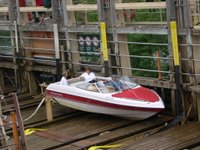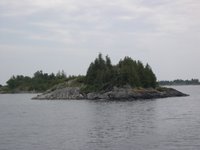We were not looking forward to driving in Quebec, since the road signs are only in French. In Ontario, they were in both French and English. While in Ottawa, we drove across the Ottawa River into Gatineau, Quebec, and had a really hard time navigating. However, our trip from Ottawa to Montreal went without a hitch. The signs had many international symbols on them, the traffic lanes inside the city were clearly marked with straight ahead, right turn only, etc. We were in a real traffic jam, caused by a construction detour, and I was navigating for John with the map in my hand and Partner in my lap. A truck driver looked down and motioned for me to open the window. When I did, he asked if we were lost. I said no. He said just go straight ahead to the tunnel in this lane, then he stopped and motioned us into his lane. A little further on, as he turned off to the right, he motioned us to stay in the lane where we were driving. Sure enough, it took us right into the tunnel under the St. Lawrence River and directly to our RV park. We saw other example of drivers yielding to trucks and large vehicles in Montreal. In Ontario, the drivers were rude. In Quebec, they are speeding just as much and tail-gating, but more polite.
We stayed in Camping Alouette near Montreal, a wonderful park with wi-fi, large sites, inexpensive washing machines and very helpful bi-lingual office staff and publications. We took the subway into town and enjoyed seeing the many old buildings still being used, with modern skyscrapers built next door. Some old buildings
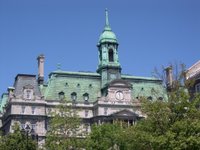 (from the 1700 and 1800s) are several stories high, with dressed stone on the fronts and rough stone on the side walls. Another building down the street might be an all-glass 25-story office building. Many of the streets are very narrow, with restaurants, cafes and shops lining them. Finally we came to Place Jacque Cartier, where there were many tourist oriented shops and restaurants, including an amazing number of Italian restaurants. Why here? We don’t know. We ate across the street from the Montreal Town Hall, a beautiful building with green-copper roof.
(from the 1700 and 1800s) are several stories high, with dressed stone on the fronts and rough stone on the side walls. Another building down the street might be an all-glass 25-story office building. Many of the streets are very narrow, with restaurants, cafes and shops lining them. Finally we came to Place Jacque Cartier, where there were many tourist oriented shops and restaurants, including an amazing number of Italian restaurants. Why here? We don’t know. We ate across the street from the Montreal Town Hall, a beautiful building with green-copper roof.Next we were on to Quebec. What a wonderful old city! We love it. We stayed at Camping Transit south of the city in Levis. The office staff is bilingual, though the brochure is all in French. They are equally helpful and the sites are large. The park was crammed full on Saturday night. Apparently everything in town was as crowded—it is construction holiday. (During the last two weeks of July most construction workers and some of the businesses that support construction shut down for a summer holiday.) The streets in the Petit Champlain and Rue St. Jean
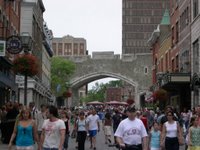 areas of Quebec were just as packed and there wasn’t even anything special going on that weekend. We took the ferry from Levis to Quebec, a 10-15 minute ride across the St. Lawrence River. Many people spend their Saturdays bicycling here and a number took the ferry to visit the other side of the river.
areas of Quebec were just as packed and there wasn’t even anything special going on that weekend. We took the ferry from Levis to Quebec, a 10-15 minute ride across the St. Lawrence River. Many people spend their Saturdays bicycling here and a number took the ferry to visit the other side of the river.We packed our own lunch and ate in a small park, which included sparrows begging for food and a children’s sand box. Quebec is the only walled city in North America north of Mexico. We walked part of the Remparts (French spelling), saw the Citadel, Cathedral of Notre Dame and many interesting shops, as well as two streets lined with artists drawing portraits or selling street scenes. The weather has finally cooled a little and it was a great day.
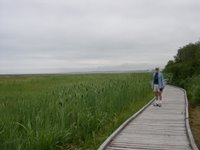
When we left Quebec City, we drove east along the St. Lawrence River to Rimouski, a smallish city right along the river. We can look across the street and see the St. Lawrence, looking more like the ocean. The RV park is full, mainly with people from throughout the Province of Quebec. It is definitely summer holiday time. While in Rimouski we walked about five miles on a lovely biking/walking trail along the river, then drove to Sainte Flavien, a small artist colony about 15 miles downriver, where we visited several galleries and boutiques. Next door to the tourist information office was a house with an absolutely beautiful garden. What a treat!
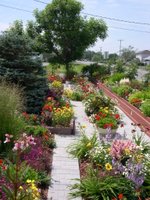
Some of the differences between the Province of Ontario and Quebec are amazing. Ontario is so oriented to recycling, even provincial parks have bins for metal, plastic and paper. One park even had a sign saying garbage only, no recyclables, on the dumpster. But in Quebec, we had one park with a bin to recycle paper, but no emphasis on metal or plastic, even though we pay a deposit on a 12-pak of Coke.
Carrying out everyday activities in a French-speaking province is a challenge. In Ontario we encountered a traffic sign “Advance green when flashing.” We had to ask what it meant—you can make a left turn on flashing green lights. Then we get to Quebec and the sign says “----- ------ ----- ----- vert.” From buying haricots verts (green beans) we learned what vert means. When the green traffic light flashed and the opposing traffic didn’t move, we decided the French sign meant left turn on flashing green. All pre-packaged food has labels in both French and English throughout Canada. But signs in the aisles, and on fresh fruits and vegetables and some meats are only in French. “Frommes and Legumes” means fruits and vegetables. It makes going to the grocery store exciting.
From Rimouski we are on to New Brunswick.

